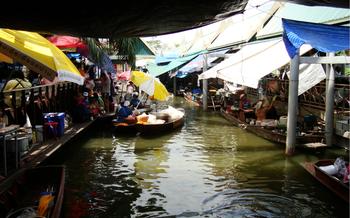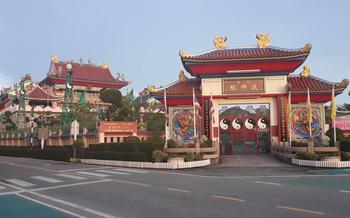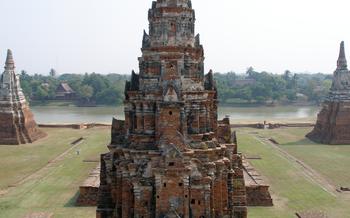
Ban Chiang Archaeological Site
- The Antiquity of Ban Chiang
- Journey to the Past
- Excavating History
- Unraveling the Ban Chiang Culture
- The Ban Chiang Museum
- Bronze Age Artifacts
- Ancient Burials
- Chronological Controversies
- International Recognition
- Local Crafts and Handicrafts
- Explore the Surrounding Area
- Festivals and Events
- Local Cuisine
- Insider Tip
The Antiquity of Ban Chiang
The Ban Chiang archaeological site in Thailand holds immense historical significance as one of the world's earliest centers of civilization. Excavations conducted at the site have revealed evidence of human habitation dating back to the 4th millennium BCE, making it one of Southeast Asia's oldest settlements. The discovery of bronze artifacts, pottery, and other relics has provided crucial insights into the development of complex societies in the region. Ban Chiang's profound antiquity and contributions to our understanding of human history have led to its recognition as a UNESCO World Heritage Site.
A visit to Ban Chiang offers a glimpse into the lives of our distant ancestors and the origins of human civilization. The site's well-preserved artifacts and comprehensive museum provide visitors with an opportunity to journey back in time and explore the rich cultural heritage of Thailand and Southeast Asia.
Journey to the Past
In the northeastern province of Sakon Nakhon, Thailand, lies the Ban Chiang Archaeological Site, a place that takes you on a journey back in time. Located approximately 50 kilometers from the city center, the site can be reached by private transportation or by guided tours organized by local tour operators. The drive offers a glimpse into the serene rural landscape, dotted with rice paddies and small villages.
Guided tours are highly recommended for a deeper understanding of the site's history and significance. These tours are led by knowledgeable guides who provide insightful commentary and explanations throughout the visit. Advance booking for guided tours is advisable to ensure availability, especially during peak tourist seasons.
Excavating History
The excavation of the Ban Chiang site began in the early 1960s, led by American archaeologist Chester Gorman. The initial excavations revealed a rich array of artifacts, including pottery, bronze objects, and human remains. These discoveries sparked international interest and led to further research and excavations. In the 1970s, Thai archaeologists joined the project, and international collaboration intensified. Subsequent excavations uncovered additional pottery kilns, bronze workshops, and burial grounds, providing valuable insights into the daily life and cultural practices of the Ban Chiang people. The findings from Ban Chiang have revolutionized our understanding of Southeast Asian prehistory, pushing back the timeline of human settlement in the region by several thousand years.
Unraveling the Ban Chiang Culture
The excavations at Ban Chiang have shed light on a distinctive culture that flourished in the region thousands of years ago. The Ban Chiang people were adept at pottery-making, bronze metallurgy, and rice cultivation, demonstrating their advanced skills and knowledge. Their daily life revolved around agriculture, with evidence suggesting the domestication of animals and the cultivation of a variety of crops. The social organization of the Ban Chiang culture is still being studied, but it is believed that they lived in small, egalitarian communities. The discovery of elaborate burials and grave goods suggests that they had a complex belief system and a concept of an afterlife. The study of the Ban Chiang culture has greatly contributed to our understanding of prehistoric Southeast Asia, providing insights into the development of early civilizations in the region.
The Ban Chiang Museum
In the heart of the Ban Chiang Archaeological Site, the Ban Chiang Museum stands as a testament to the site's rich history and cultural significance. Housing a comprehensive collection of artifacts unearthed during excavations, the museum offers visitors an immersive journey into the past. From exquisite pottery to bronze artifacts and burial remains, the exhibits showcase the daily life, technological advancements, and social customs of the Ban Chiang people. Interactive displays and educational panels provide detailed insights into the culture and its impact on the region's history. Guided tours and audio guides are available to enhance the visitor experience, offering deeper knowledge and context for understanding the significance of this remarkable archaeological site.
Bronze Age Artifacts
The excavation of Ban Chiang has yielded a wealth of bronze artifacts, shedding light on the early metalworking skills and craftsmanship of this ancient civilization. Among the most notable discoveries are bronze tools, weapons, and ornaments. Bronze tools, such as axes, adzes, and chisels, were essential for woodworking, agriculture, and other daily tasks. Bronze weapons, including spearheads, arrowheads, and swords, suggest that the Ban Chiang people engaged in hunting, warfare, or both. Bronze ornaments, such as earrings, bracelets, and pendants, indicate a sense of personal adornment and social status. The presence of bronze artifacts at Ban Chiang demonstrates the technological advancements of this Bronze Age society and their mastery of metalworking techniques. These discoveries have significantly contributed to our understanding of the transition from the Neolithic to the Bronze Age in Southeast Asia.
Ancient Burials
Excavations at Ban Chiang have unearthed numerous burial sites, offering valuable insights into the burial practices and rituals of the ancient inhabitants. Burials were typically conducted in earthen pits, with the bodies placed in a flexed or extended position. Accompanying the deceased were a range of artifacts, including pottery vessels, bronze ornaments, and personal belongings. These grave goods provide clues about the social status and wealth of the individuals, as well as their beliefs and expectations regarding the afterlife.
The discovery of multiple burial sites has allowed archaeologists to identify patterns and variations in burial practices over time. This has shed light on the social stratification and status differentiation that existed within the Ban Chiang community. The presence of elaborate grave goods in certain burials suggests that some individuals held positions of power or prestige within the society. The burials also provide evidence of symbolic practices and beliefs related to the afterlife, such as the placement of food and other offerings alongside the deceased.
Chronological Controversies
In the initial stages of research, the Ban Chiang site was believed to date back to 3600 BCE, making it one of the oldest Neolithic sites in Southeast Asia. However, subsequent excavations and further analysis led to debates and revisions in the site's chronology. Some scholars challenged the initial dating, arguing that the artifacts and pottery styles suggested a later period.
This sparked a series of discussions and re-evaluations, with experts employing advanced dating techniques and re-examining existing evidence. As a result, the chronology of the Ban Chiang site has been revised, with some researchers proposing a date range of 2100 to 1500 BCE. These ongoing discussions and revisions highlight the importance of accurate dating in understanding cultural development and the dynamics of ancient societies.
International Recognition
The global significance of the Ban Chiang site was formally recognized when it was declared a UNESCO World Heritage Site in 199This prestigious designation highlights the site's exceptional cultural and historical value, placing it among the most important archaeological treasures in the world.
UNESCO's recognition has brought international attention and acclaim to Ban Chiang, attracting researchers, scholars, and tourists from around the globe. It has also prompted increased efforts to preserve and protect the site, ensuring its legacy for future generations.
In addition to UNESCO's recognition, the Ban Chiang site has received numerous other accolades and awards, including the Thailand National Museum Award for Outstanding Archaeological Discovery and the Asia-Pacific Heritage Award for Cultural Heritage Conservation. These awards further underscore the site's importance and its contribution to our understanding of Southeast Asian history.
Preservation efforts at Ban Chiang have focused on protecting the archaeological remains and promoting sustainable tourism practices. The site is now managed by the Fine Arts Department of Thailand, which has implemented measures to control visitor numbers and minimize damage to the fragile artifacts.
The Ban Chiang World Heritage Site serves as a symbol of Thailand's rich cultural heritage and its commitment to preserving its past for future generations. It is a testament to the ingenuity and creativity of the ancient Ban Chiang people and a reminder of the enduring power of human history.
Local Crafts and Handicrafts
In the Ban Chiang region, the tradition of pottery-making is still alive and thriving. Local artisans have inherited the skills and techniques of their ancestors, passing them down through generations. Visitors can witness the intricate process of pottery-making firsthand, from molding the clay to firing the finished products in traditional kilns.
Workshops and demonstrations are often held, allowing visitors to learn about the techniques and even try their hand at pottery-making. This is an excellent opportunity to gain a deeper appreciation for the craftsmanship and skill involved in creating these beautiful objects.
At the Ban Chiang Pottery Center, visitors can purchase authentic souvenirs and support local artisans. The center showcases a wide range of pottery items, including replicas of ancient Ban Chiang pottery, as well as contemporary pieces that reflect modern interpretations of traditional designs.
Purchasing a locally made souvenir not only supports the local economy but also helps preserve and promote the unique cultural heritage of the Ban Chiang region. These handicrafts are a tangible reminder of the region's rich history and traditions, and they make for meaningful and unique souvenirs to take home.
Explore the Surrounding Area
Beyond the archaeological wonders of Ban Chiang, the region offers a wealth of natural and cultural attractions. The Phu Phan Mountains, located just a short drive away, beckon with their majestic peaks and breathtaking views. Embark on a scenic hike or bike ride through the rugged terrain, and discover hidden waterfalls, lush forests, and panoramic vistas.
For those seeking water-based adventures, the Nam Si Suphan Reservoir is a haven for outdoor enthusiasts. Cast your line into the shimmering waters and try your luck at fishing, or glide across the tranquil surface in a kayak or paddleboat. The reservoir's serene setting and abundant birdlife make it an ideal spot for nature lovers and photographers alike.
Cultural attractions are also plentiful in the vicinity of Ban Chiang. Visit nearby temples, such as Wat Pa Daeng, to admire their intricate architecture and learn about local religious traditions. Immerse yourself in the vibrant local culture by attending one of the many festivals and events held throughout the year. These celebrations offer a glimpse into the region's rich heritage, with traditional music, dance, and colorful processions.
Festivals and Events
In addition to its historical significance, Ban Chiang is renowned for its lively festivals and events that celebrate the local culture and traditions. The annual Ban Chiang Pottery Fair is a highlight, typically held in January or February. During this vibrant festival, visitors can witness skilled artisans showcasing their pottery-making skills, attend workshops and demonstrations, and purchase unique handmade souvenirs. Cultural performances, traditional music, and delicious local cuisine add to the festive atmosphere. It's an exceptional opportunity to immerse yourself in the vibrant spirit of Ban Chiang and experience the warmth and hospitality of its people.
Local Cuisine
Savor the Flavors of Sakon Nakhon
Sakon Nakhon's cuisine is a delightful blend of regional specialties and fresh local ingredients. Seafood enthusiasts will relish the abundance of freshwater fish and shrimp from the nearby water bodies, prepared in a variety of traditional and innovative dishes. Visitors can indulge in culinary delights at local markets, sampling street food and fresh produce, or savor regional delicacies at local restaurants. The region's unique flavors and culinary traditions offer an immersive experience that complements the cultural and historical exploration of Ban Chiang.
Insider Tip
For an optimal experience, plan your visit during the dry season (November to April) when the weather is at its best, with clear skies and pleasant temperatures. This will allow you to fully appreciate the outdoor aspects of the site and the surrounding natural beauty.
Consider staying in a nearby village to immerse yourself in the local way of life. This will provide an opportunity to engage with the friendly locals, learn about their culture, and sample authentic regional cuisine. Homestays and guesthouses are available for a more intimate and authentic experience.
Take advantage of guided tours to gain deeper insights into the site's history and significance. Knowledgeable guides can provide fascinating details about the archaeological discoveries, the Ban Chiang culture, and the ongoing research. Guided tours are available in various languages, ensuring that visitors from all over the world can appreciate the site's rich heritage.




